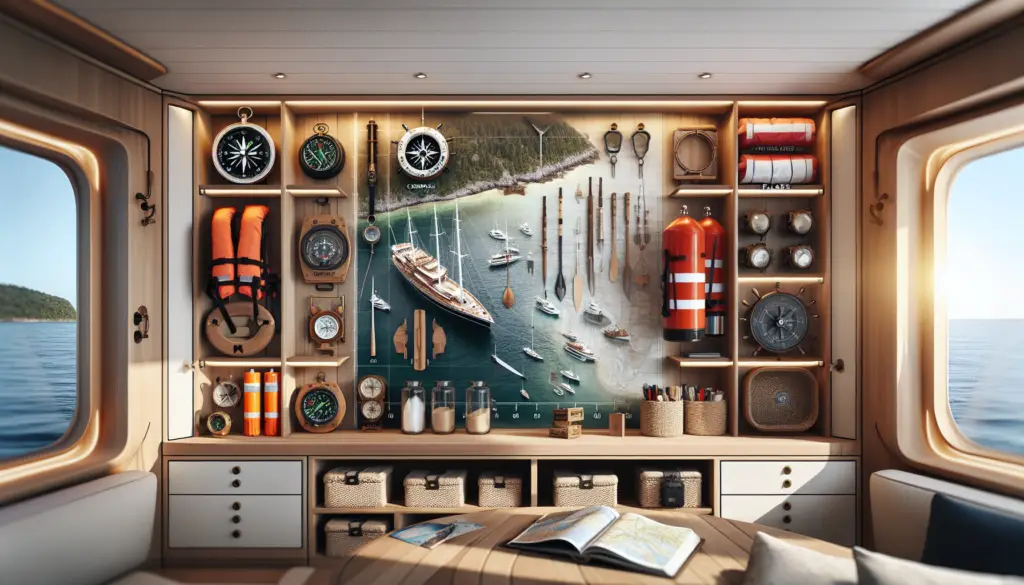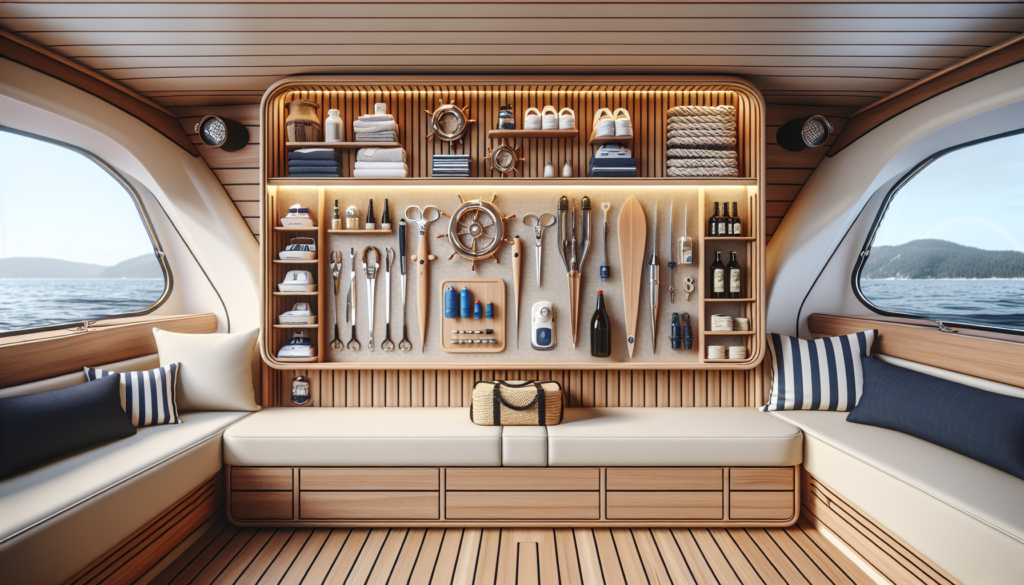Are you tired of clutter taking over your boat? Are you in need of more storage space to keep your belongings organized? If so, look no further! This article will provide you with all the essential tips and tricks on how to add custom shelving and storage to your boat. By following these simple steps, you’ll be able to maximize the available space on your boat and create a neat and efficient storage solution that suits your specific needs. Say goodbye to the frustration of not being able to find what you need when you need it, and say hello to a well-organized and clutter-free boating experience.

Planning and Designing your Custom Shelving and Storage
Assessing your storage needs is the first step in planning and designing custom shelving and storage for your boat. Take some time to evaluate the items you need to store and organize. Consider the types of items you have, their dimensions, and the quantity that needs to be stored. This will help you determine the size and design of your shelves.
Once you have assessed your storage needs, it is time to determine the style and material of your shelves. Consider the overall design aesthetic of your boat and choose a style that complements it. Additionally, think about the material that will best suit your storage needs. Wood is a popular choice for its natural beauty, while metal offers durability and a sleek look.
Measuring the available space is crucial when designing custom shelving. Take accurate measurements of the areas where you plan to install the shelves. Consider any obstacles or existing fixtures that might affect the design or placement of your shelves. With accurate measurements, you can create a layout and design plan that maximizes the available space and meets your storage needs.
Creating a layout and design plan will ensure that your custom shelving and storage solution is functional and aesthetically pleasing. Sketch out the desired layout and placement of the shelves. Consider factors such as accessibility, visibility, and the overall flow of the space. This plan will serve as a guide when building and installing your custom shelving.
Choosing the Right Materials for Your Custom Shelving
When it comes to choosing the right materials for your custom shelving, there are a few factors to consider. First and foremost, think about the boat’s environment. It’s important to select materials that can withstand the harsh marine conditions, such as exposure to saltwater, humidity, and UV rays. Look for materials that are resistant to corrosion, rot, and warping.
Opting for lightweight and durable materials is essential for boat storage solutions. Remember that your shelves will need to support the weight of your belongings, so choosing sturdy materials is crucial. Lightweight materials will also help maintain the balance and stability of your boat. Consider materials such as aluminum, fiberglass, or marine-grade plywood.
Exploring different options such as wood or metal can help you achieve the desired look and functionality for your custom shelving. Wood offers a classic and warm aesthetic, while metal provides a modern and sleek appearance. Both materials have their pros and cons, so weigh them against your specific storage needs and preferences.
Evaluating the pros and cons of various materials will help you make an informed decision. Consider factors such as cost, durability, maintenance requirements, and compatibility with your boat’s design. Look for materials that are easy to clean and maintain, as this will ensure that your custom shelving remains in good condition for years to come.

Building Custom Shelving and Storage
Gathering the necessary tools and materials is the first step in building custom shelving and storage for your boat. Make sure you have all the tools and materials listed in your design plan. Common tools include a tape measure, saw, drill, screws, and a level. Additionally, ensure that you have the appropriate safety equipment, such as goggles and gloves.
Cutting and shaping the shelves is the next step in building your custom storage solution. Using the measurements from your design plan, carefully cut the shelves to the desired dimensions. Take your time and use precision tools to ensure clean and accurate cuts. If using wood, consider sanding the edges for a smooth finish.
Assembling the shelves and storage units is a crucial part of the building process. Follow your design plan and carefully connect the pieces using screws or appropriate connectors. Take care to align the shelves properly and ensure they are level. If using metal, consider using welding or metal connectors for a secure and durable assembly.
Securing the shelving units in your boat is the final step in the building process. Use appropriate mounting hardware and techniques to ensure that your shelves are securely attached. Consider using brackets, cleats, or support legs, depending on the design and weight of your shelves. Make sure to follow the manufacturer’s instructions and consult any applicable safety guidelines.
Installing and Mounting Custom Shelves
Determining the right mounting locations is crucial for a successful installation of your custom shelves. Refer to your design plan and take into account factors such as accessibility and weight distribution. Consider mounting the shelves in areas where they can be easily reached and where the weight can be evenly distributed. Avoid areas that may obstruct movement or interfere with other boat features.
Preparing the mounting surfaces is an important step to ensure a secure and long-lasting installation. Clean and remove any debris from the mounting surfaces to ensure proper adhesion or attachment. If necessary, apply a primer or sealer to prevent moisture or corrosion. Make sure the surfaces have sufficient strength and stability to support the weight of the shelves.
Installing brackets and supports is crucial for keeping your custom shelves in place. Choose brackets and supports that are suitable for the material and design of your shelves. Follow the manufacturer’s instructions for installation and make sure the brackets are securely attached to both the shelves and the mounting surfaces. Use appropriate screws or fasteners based on the material of your shelves.
Securing the shelves in place is the final step in installing your custom shelving. Once the brackets and supports are in place, carefully position the shelves and attach them to the brackets. Make sure the shelves are level and adjust as needed. Double-check that all connections are secure and that the shelves can withstand the weight of your belongings.

Enhancing Storage Functionality
Adding adjustable shelves and dividers can greatly enhance the functionality of your custom storage solution. Adjustable shelves allow you to rearrange the storage spaces based on your changing needs. Dividers can help keep items organized and prevent shifting or damage during boat movements. Consider incorporating these features for a versatile and efficient storage system.
Incorporating storage bins or baskets can further optimize your boat’s storage capabilities. Use bins or baskets to store smaller items or group similar items together. This will help keep your belongings organized and easily accessible. Look for bins or baskets that are durable and resistant to moisture or corrosion.
Utilizing underutilized spaces is a great way to maximize your boat’s storage potential. Identify areas that are currently unused or wasted and find creative ways to add storage there. Consider installing shelves or cabinets in corners, under seats, or even on the insides of doors. Every inch of space counts when it comes to creating an efficient storage system.
Incorporating hooks and racks is another effective way to store smaller items and keep them within reach. Install hooks in strategic locations to hang coats, hats, or towels. Use racks to store fishing rods, life jackets, or other equipment. These simple additions can free up valuable shelf or floor space while keeping items neatly organized.
Optimizing Storage Solutions
Utilizing vertical space is a smart strategy to optimize your boat’s storage solutions. Consider installing tall shelves or cabinets that reach up to the ceiling. This will make use of the often overlooked vertical space and provide additional storage capacity. Use sturdy materials and proper anchoring techniques to ensure the stability and safety of these tall storage solutions.
Building overhead storage compartments is another effective way to optimize storage in your boat. Utilize the space above seating areas or in cabins to create overhead storage compartments. These compartments can be used to store items that are not frequently accessed or seasonal items. Consider using hinged or sliding doors for easy access and to keep items securely stored.
Installing under-seat storage is a practical solution for maximizing space on your boat. Many boats have seating areas that can be transformed into storage compartments. Install hinges or latches on the seats, allowing them to be lifted and revealing storage space underneath. This is a great way to store larger items or items that are not frequently used.
Creating custom storage solutions for specific items is a thoughtful way to optimize your boat’s storage. Identify any specific items or equipment that require special storage and design customized solutions for them. For example, fishing poles can be stored in specialized rod holders, while cooking utensils can have designated storage compartments in the galley. Tailoring storage to specific needs will increase efficiency and keep your belongings easily accessible.

Incorporating Locking Mechanisms and Safety Features
Installing locks to secure valuable items is a wise decision for added security. Consider installing locks on storage compartments or cabinets that contain valuable items such as electronics, jewelry, or personal documents. Choose locks that are suitable for marine environments, resistant to saltwater corrosion, and easy to use. This will give you peace of mind knowing that your belongings are secure while onboard or away from your boat.
Adding latches to prevent shelves from moving during navigation is an essential safety feature. As boats experience movement and vibrations during navigation, it’s important to ensure that the shelves remain stable and secure. Install latches or fasteners that can keep the shelves in place, preventing them from sliding or shifting during rough water conditions. This will reduce the risk of accidents and damage to items stored on the shelves.
Ensuring safety measures for hazardous items is crucial for the well-being of everyone onboard. If your boat carries hazardous substances such as fuel, cleaning agents, or chemicals, it’s important to store them properly and securely. Designate specific storage areas for these items, ensuring they are properly labeled and stored in accordance with safety regulations. Consider using lockable cabinets or specialized containers to prevent accidental spills or exposure.
Considering fire safety precautions is of utmost importance when designing custom shelving and storage. Make sure that your storage solutions allow for proper ventilation and do not obstruct access to firefighting equipment or emergency exits. Use fire-resistant materials whenever possible and ensure that flammable items are stored according to safety guidelines. Think about adding fire extinguishers or fire suppression systems to further enhance fire safety on your boat.
Custom Shelving for Specific Boat Areas
Customizing shelving for the galley or kitchen area can greatly enhance its functionality. Consider the specific needs of your galley, such as storing cookware, utensils, or food supplies. Install shelves or cabinets that are appropriately sized and designed for these items. Take into account factors such as accessibility, organization, and proper ventilation for perishable items.
Designing storage solutions for the cabin or sleeping quarters is essential for a comfortable and organized living space. Incorporate shelves or cabinets that can store clothes, personal items, or bedding. Consider incorporating features such as drawers, hanging spaces, or shoe racks to optimize the storage capacity. Keep in mind the limited space in the cabin and design solutions that maximize functionality without compromising comfort.
Creating specialized storage for fishing equipment is a must for fishing enthusiasts. Install dedicated rod holders, tackle boxes, or compartments for fishing gear. Consider materials and designs that are resistant to corrosion and can withstand exposure to water and UV rays. Optimize the storage space to accommodate various fishing equipment, ensuring their safety and accessibility.
Adapting shelving for the engine room or mechanical areas is crucial for maintaining your boat’s equipment. Install shelves or cabinets that can store spare parts, tools, or maintenance supplies. Consider the specific requirements of these areas, such as heat resistance, proper ventilation, and easy access to equipment. Ensure that the storage solutions do not hinder maintenance activities or obstruct critical mechanical components.

Maintaining and Upgrading Custom Shelving
Regular cleaning and organizing is key to maintaining the functionality and longevity of your custom shelving. Take the time to clean and inspect the shelves regularly. Remove any dust, debris, or moisture that may have accumulated. Keep the shelves organized by grouping similar items together and discarding any unnecessary or expired items.
Inspecting shelves for damage or wear is an important part of maintenance. Check for signs of warping, cracks, or loose connections. Address any issues promptly to prevent further damage or compromise to the shelves. Consider applying protective coatings or finishes to maintain the appearance and durability of the shelves.
Making necessary repairs or replacements is essential to keep your custom shelving in good condition. If you notice any damage or wear that cannot be repaired, consider replacing the affected parts or the entire shelving unit if necessary. By addressing issues early on, you can prevent more extensive damage and ensure the longevity of your custom storage solution.
Upgrading storage solutions as needs change is a proactive approach to maintaining an efficient storage system. As your storage needs evolve, consider modifying or expanding your custom shelving. Assess whether additional shelves, dividers, or organizational tools are necessary. Stay attuned to the changing requirements of your boat’s storage and make the necessary upgrades to accommodate them.
Considering Professional Help
Hiring a professional boat outfitter or carpenter is a wise choice if you are not confident in your DIY skills or if you have complex design requirements. A professional can offer expertise and experience in designing and building custom shelving for boats. They can provide valuable advice on maximizing space, optimizing functionality, and ensure compliance with safety regulations.
Seeking expertise for intricate or complex designs is beneficial when you have specific design ideas or unique requirements. Professionals can bring your vision to life and offer creative solutions to overcome design challenges. They have the tools, skills, and expertise to execute complex designs accurately and efficiently.
Obtaining advice on maximizing space and functionality is valuable for ensuring that your custom shelving meets your storage needs. Professionals can assess your boat’s layout and provide recommendations on how to optimize storage in different areas. They can suggest creative storage solutions and help you make the most of the available space onboard.
Ensuring compliance with safety regulations should be a priority when designing and installing custom shelving. Professionals are well-versed in safety regulations and can ensure that your shelving meets the required standards. They can help you navigate any applicable safety guidelines and ensure the safety of your boat and its occupants.
In conclusion, adding custom shelving and storage to your boat requires careful planning, thoughtful design, and precise execution. By assessing your storage needs, selecting the right materials, and following proper installation techniques, you can create a customized storage solution that is efficient, functional, and aesthetically pleasing. Consider incorporating various organizational features, optimizing storage solutions, and incorporating safety measures to enhance the functionality and safety of your boat’s storage system. Whether you choose to embark on a DIY project or seek professional help, custom shelving and storage will greatly improve the organization and usability of your boat.

